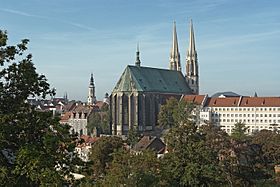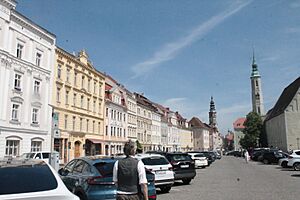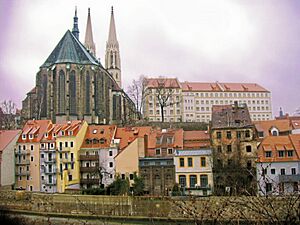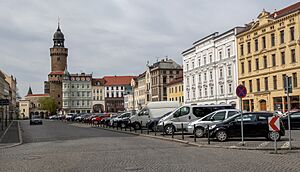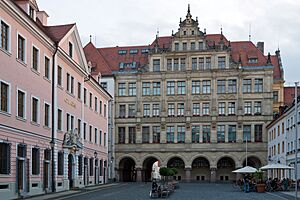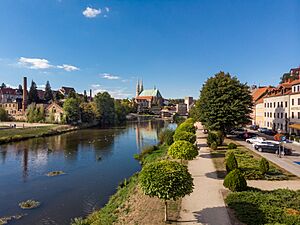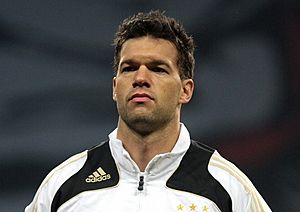Görlitz facts for kids
Quick facts for kids
Görlitz
Zgorzelec Zhorjelc Zgórjelc Zhořelec |
|||
|---|---|---|---|
|
Clockwise from top: St Peter and Paul Church; Upper Lusatian Library of Sciences; towers of Görlitz: city hall, Trinity Church, Reichenbach Tower and Luther Church; view over the city to Landeskrone Mountain; Görlitz Department Store; Lower Market Square with the city hall
|
|||
|
|||
| Country | Germany | ||
| State | Saxony | ||
| District | Görlitz | ||
| Elevation | 199 m (653 ft) | ||
| Population
(2022-12-31)
|
|||
| • Total | 56,574 | ||
| Time zone | CET/CEST (UTC+1/+2) | ||
| Postal codes |
02826–02828
|
||
| Dialling codes | 03581 | ||
| Vehicle registration | GR | ||
Görlitz is a city in the German state of Saxony. It sits on the Lusatian Neisse river. Görlitz is the biggest city in Upper Lusatia and the second largest in the wider Lusatia region. It is the easternmost city in Germany.
Right across the river is the Polish city of Zgorzelec. Zgorzelec used to be the eastern part of Görlitz until 1945. Today, Görlitz has about 56,000 people. This makes it the sixth-largest city in Saxony. Görlitz and Zgorzelec together form a "Euro City" with about 86,000 people.
Görlitz has a long and interesting history. It started as a Sorbian settlement in the 11th century. Over time, it was ruled by Germans, Czechs, Poles, and Hungarians. From 1815 to 1945, Görlitz was part of Prussia. After World War II, the city was divided. The western part became part of East Germany and then Germany again in 1990. The eastern part became Zgorzelec in Poland.
The city has a mix of cultures. Even though it's in Saxony, people also feel connected to Upper Lusatia. The local dialect is different from other parts of Saxony. There's also a strong Silesian influence because Görlitz was once part of Silesia. You can see this in some local foods and the Silesian Museum. Since Sorbs first settled the area, some names of places in Görlitz come from the Slavic language.
Görlitz was lucky during World War II and wasn't destroyed. This means it has many old and beautiful buildings. Because of its historic look, many movies have been filmed here.
Contents
History of Görlitz
Early Times and Growth
In the early Middle Ages, Slavic tribes moved into this area. The nearby Landeskrone mountain was an important stronghold. The name "Görlitz" might come from a Slavic word meaning "burned land." This refers to how people cleared land for farming.
In 990, the Sorbian Milceni tribe came under the control of the Holy Roman Empire. In 1002, a Polish ruler took over for a short time. Then, in 1075, Görlitz became part of the Duchy of Bohemia. The city was first mentioned in a document in 1071. This document gave Görlitz to the church.
The exact date Görlitz became a city is not known. But by the 13th century, it was growing into a town. Its location on the Via Regia, an old trade route, helped it become rich.
In 1319, Görlitz briefly joined a Polish duchy. Later, it returned to Bohemia. From 1346, Görlitz was a rich member of the Lusatian League. This was a group of six wealthy cities that worked together. In 1352, German settlers from Görlitz founded the city of Gorlice in Poland. For a short time, from 1377 to 1396, Görlitz was the capital of its own small duchy. It then returned to Bohemian rule.
Later Years and Changes
The Protestant Reformation arrived in Görlitz in the early 1500s. By the late 1500s, most people in the area were Lutheran Protestants.
During the Thirty Years' War in the 1600s, different armies captured Görlitz. In 1635, Görlitz and the Upper Lusatia region became part of Saxony. After the Napoleonic Wars in 1815, Görlitz was transferred from Saxony to Prussia. It remained part of Prussia until 1945.
During World War I, a camp for Greek soldiers was in the area that is now Zgorzelec. Many Greek officers lived in Görlitz itself.
In 1933, a concentration camp was set up near Görlitz. Political prisoners were held there. In 1938, during a terrible event called Kristallnacht, there was an attack on the Görlitz Synagogue. Firefighters bravely stopped the fire, saving the building. It is the only synagogue in Saxony that survived the Nazi era. Many Jewish people left the city before World War II. Those who remained were sadly killed during the Holocaust.
During World War II, there were also Nazi prisons and forced labor camps in and around Görlitz. Prisoners of war were forced to work there.
Near the end of World War II, German troops destroyed all bridges over the Lusatian Neisse river. In 1945, the border was redrawn. This split Görlitz into two cities. The part on the right bank became Zgorzelec in Poland. The main part on the left bank became part of East Germany.
Modern Görlitz
When Germany reunited in 1990, Görlitz became part of the state of Saxony again. In 1972, the border between East Germany and Poland opened for a while. This allowed people to travel easily between Görlitz and Zgorzelec. The border was closed again in 1980.
In 2002, a large lake called Lake Berzdorf began to be filled. It was once a coal mine. The "Old Town Bridge" connecting Görlitz and Zgorzelec was rebuilt and opened in 2004. When Poland joined the Schengen Agreement in 2007, border checks disappeared. Now, people can walk freely between the two cities.
Since Germany reunited, over 700 buildings in Görlitz have been fixed up. The city is becoming a popular place for tourists. An anonymous donor has given over €10,000,000 since 1995 to help renovate the city's buildings. In 2021, the old Görlitz Synagogue was reopened.
Arts and Culture in Görlitz
Today, Görlitz and Zgorzelec are well connected. They have rebuilt bridges and a bus line runs between them. Both city councils even hold joint meetings.
Görlitz has many beautiful old buildings from different time periods. These include Gothic, Renaissance, Baroque, and Art Nouveau styles. The Schönhof is one of Germany's oldest Renaissance buildings. There is also a model of the Holy Sepulchre that was started in 1465.
In 2006, Görlitz and Zgorzelec tried to become the "European City of Culture." They didn't win, but the effort helped them become known as the "City of Culture." This helps improve German-Polish relations and brings in tourists.
The Silesian Museum in Görlitz tells the story of Silesia's 1000-year culture. Görlitz is also the birthplace of "Liebesperlen," which means "love pearls." These are small, colorful candies invented by Rudolf Hoinkis.
Geography and Climate of Görlitz
Görlitz is right on the border with Poland. It is next to the Polish city of Zgorzelec, across the Lusatian Neisse river. The city is about 19.4 kilometers long and 7.3 kilometers wide. Its total area is 67.52 square kilometers.
City Parts and Transport
Görlitz is divided into 9 city parts and 8 village parts.
- City parts: Historische Altstadt, Innenstadt, Nikolaivorstadt, Südstadt, Rauschwalde, Biesnitz, Weinhübel, Königshufen and Klingewalde.
- Village parts: Ober-Neundorf, Ludwigsdorf, Schlauroth, Kunnerwitz, Klein Neundorf, Deutsch-Ossig, Hagenwerder and Tauchritz.
The Görlitz station connects the city to Berlin and Dresden by train. You can also take a train to Wrocław, Poland. Inside the city, you can use the Görlitz tramway and bus services. Buses also connect Görlitz with Zgorzelec.
Weather in Görlitz
Görlitz has a climate that is a mix of oceanic and humid continental. Summers can be warm, and winters are cold. Snow falls sometimes but doesn't usually stay all winter.
| Climate data for Görlitz (1991–2020 normals) | |||||||||||||
|---|---|---|---|---|---|---|---|---|---|---|---|---|---|
| Month | Jan | Feb | Mar | Apr | May | Jun | Jul | Aug | Sep | Oct | Nov | Dec | Year |
| Record high °C (°F) | 14.3 (57.7) |
15.9 (60.6) |
22.5 (72.5) |
30.2 (86.4) |
30.0 (86.0) |
32.7 (90.9) |
35.7 (96.3) |
34.0 (93.2) |
32.1 (89.8) |
26.0 (78.8) |
18.4 (65.1) |
15.3 (59.5) |
35.7 (96.3) |
| Mean daily maximum °C (°F) | 2.2 (36.0) |
3.7 (38.7) |
8.0 (46.4) |
14.2 (57.6) |
18.7 (65.7) |
22.0 (71.6) |
24.2 (75.6) |
24.1 (75.4) |
18.8 (65.8) |
13.1 (55.6) |
7.2 (45.0) |
3.2 (37.8) |
13.3 (55.9) |
| Daily mean °C (°F) | −0.2 (31.6) |
0.9 (33.6) |
4.1 (39.4) |
9.3 (48.7) |
13.6 (56.5) |
16.9 (62.4) |
18.9 (66.0) |
18.6 (65.5) |
14.1 (57.4) |
9.4 (48.9) |
4.6 (40.3) |
1.0 (33.8) |
9.3 (48.7) |
| Mean daily minimum °C (°F) | −2.8 (27.0) |
−2.1 (28.2) |
0.4 (32.7) |
4.0 (39.2) |
8.0 (46.4) |
11.4 (52.5) |
13.4 (56.1) |
13.2 (55.8) |
9.6 (49.3) |
5.7 (42.3) |
1.9 (35.4) |
−1.3 (29.7) |
5.1 (41.2) |
| Record low °C (°F) | −27.5 (−17.5) |
−23.7 (−10.7) |
−18.2 (−0.8) |
−5.6 (21.9) |
−2.6 (27.3) |
0.2 (32.4) |
4.8 (40.6) |
4.1 (39.4) |
−0.4 (31.3) |
−5.0 (23.0) |
−14.7 (5.5) |
−21.0 (−5.8) |
−27.5 (−17.5) |
| Average precipitation mm (inches) | 44.0 (1.73) |
35.4 (1.39) |
48.5 (1.91) |
36.2 (1.43) |
59.1 (2.33) |
69.4 (2.73) |
89.1 (3.51) |
78.5 (3.09) |
54.6 (2.15) |
46.0 (1.81) |
42.8 (1.69) |
42.7 (1.68) |
646.2 (25.44) |
| Average precipitation days (≥ 1.0 mm) | 16.7 | 14.9 | 15.7 | 12.1 | 13.9 | 13.9 | 14.0 | 12.9 | 12.5 | 13.6 | 14.5 | 16.1 | 170.7 |
| Average snowy days (≥ 1.0 cm) | 14.3 | 11.5 | 5.4 | 0.9 | 0 | 0 | 0 | 0 | 0 | 0.1 | 2.5 | 8.6 | 43.3 |
| Average relative humidity (%) | 84.0 | 80.6 | 76.4 | 68.9 | 70.3 | 70.4 | 69.2 | 69.8 | 76.4 | 80.6 | 84.9 | 84.9 | 76.4 |
| Mean monthly sunshine hours | 61.3 | 82.8 | 132.0 | 192.7 | 227.1 | 227.1 | 236.2 | 228.3 | 165.8 | 122.7 | 67.7 | 56.3 | 1,791.5 |
| Source: World Meteorological Organization | |||||||||||||
Görlitz as a Film Location
Because of its historic look, Görlitz is a popular place for movies. The film Inglourious Basterds had scenes shot in the Lower Market Square and Upper Market Square. Other movies filmed here include The Book Thief and The Reader.
Görlitz was the main filming spot for the movie The Grand Budapest Hotel. A vacant department store in the city was even decorated to look like the hotel in the film.
City Government
Mayor and City Council of Görlitz
The mayor of Görlitz is Octavian Ursu. He was elected in 2019. Before 1994, the city council chose the mayor. Now, citizens vote for the mayor directly.
The city council makes decisions for Görlitz. The most recent election for the city council was in 2019. Different political parties have seats on the council.
| Candidate | Party | First round | Second round | |||
|---|---|---|---|---|---|---|
| Votes | % | Votes | % | |||
| Sebastian Wippel | Alternative for Germany | 9,710 | 36.4 | 11,390 | 44.8 | |
| Octavian Ursu | Christian Democratic Union | 8,077 | 30.3 | 14,043 | 55.2 | |
| Franziska Schubert | Green / BfG / MG / SPD / PARTEI | 7,436 | 27.9 | |||
| Jana Lübeck | The Left | 1,470 | 5.5 | |||
| Valid votes | 26,693 | 98.7 | 25,433 | 98.6 | ||
| Invalid votes | 339 | 1.3 | 370 | 1.4 | ||
| Total | 27,032 | 100.0 | 25,803 | 100.0 | ||
| Electorate/voter turnout | 46,120 | 58.6 | 46,135 | 55.9 | ||
| Source: Wahlen in Sachsen | ||||||
| Party | Votes | % | +/- | Seats | +/- | |
|---|---|---|---|---|---|---|
| Alternative for Germany (AfD) | 23,603 | 30.7 | New | 13 | New | |
| Christian Democratic Union (CDU) | 16,896 | 22.0 | 9 | |||
| Citizens for Görlitz (BfG) | 13,397 | 17.5 | 8 | |||
| The Left (Die Linke) | 6,516 | 8.5 | 3 | |||
| Alliance 90/The Greens (Grüne) | 5,847 | 7.6 | 2 | |||
| Motor Görlitz (MG) | 4,347 | 5.7 | New | 2 | New | |
| Social Democratic Party (SPD) | 1,782 | 2.3 | 1 | |||
| Down to Business! (ZS) | 1,729 | 2.3 | 0 | |||
| Free Democratic Party (FDP) | 1,663 | 2.2 | 0 | |||
| BI Seensucht | 604 | 0.8 | New | 0 | New | |
| National Democratic Party (NPD) | 376 | 0.5 | 0 | |||
| Valid votes | 26,530 | 98.0 | ||||
| Invalid votes | 544 | 2.0 | ||||
| Total | 27,074 | 100.0 | 42 | ±0 | ||
| Electorate/voter turnout | 46,119 | 58.7 | ||||
| Source: Wahlen in Sachsen | ||||||
Sister Cities and Famous People
Görlitz has several sister cities around the world. These are cities that have special friendly relationships.
Görlitz is the easternmost city in Germany. It has a special group called the "Compass Alliance" with the northernmost, westernmost, and southernmost towns in Germany. They celebrate German Unity Day together.
Famous People from Görlitz
Many interesting people were born in or lived in Görlitz.
- Michael Ballack (born 1976), a famous football (soccer) player.
- Jakob Böhme (1575–1624), a well-known mystic and theologian.
- Hans Georg Dehmelt (1922–2017), who won the Nobel Prize in Physics in 1989.
- Emil Jannings (1884–1950), the first actor to win an Academy Award for Best Actor.
- Jens Jeremies (born 1974), another well-known football player.
Images for kids
-
St. Peter and Paul church, the Woad House and the river Lusatian Neisse in Görlitz
-
Royal coats of arms of Hungarian King Matthias Corvinus (Old Town Hall)
See also
 In Spanish: Görlitz para niños
In Spanish: Görlitz para niños


